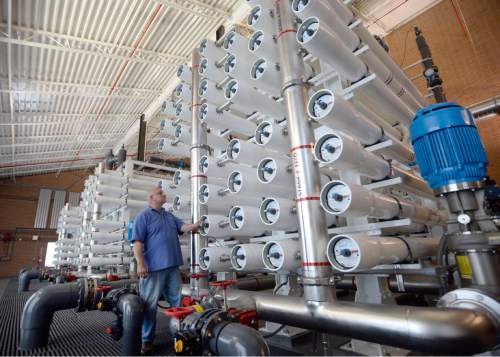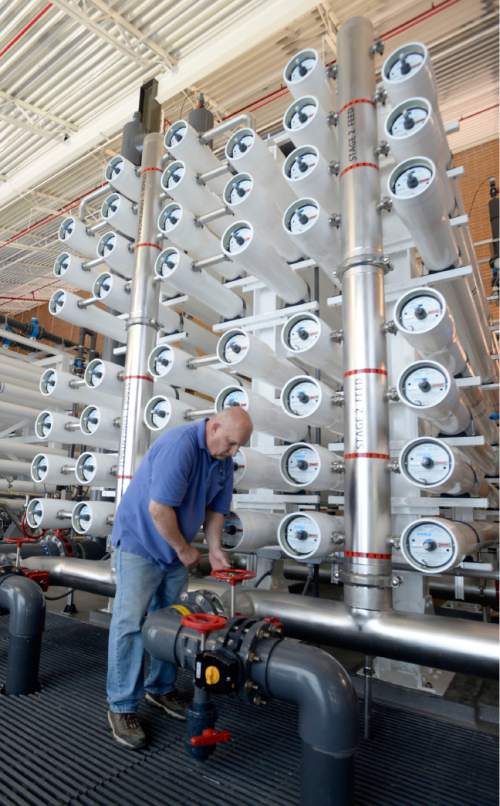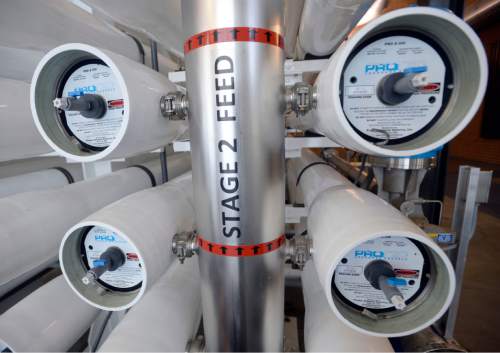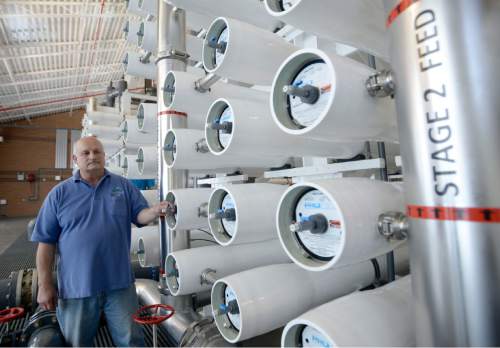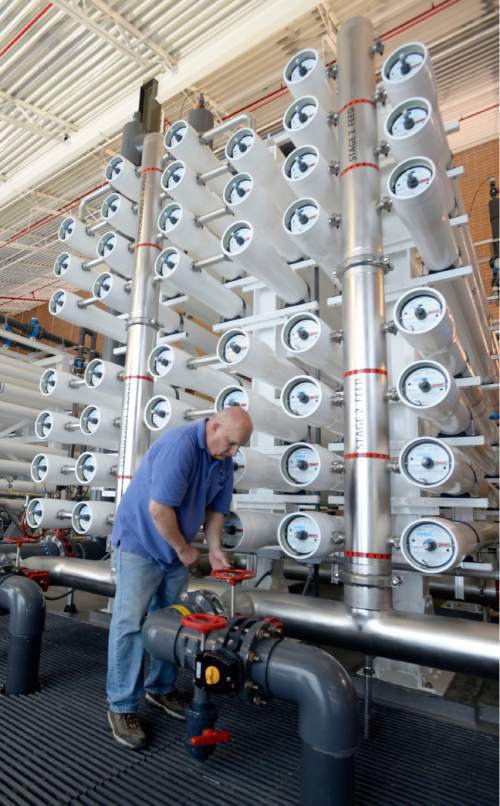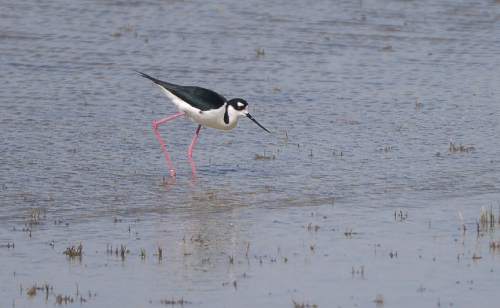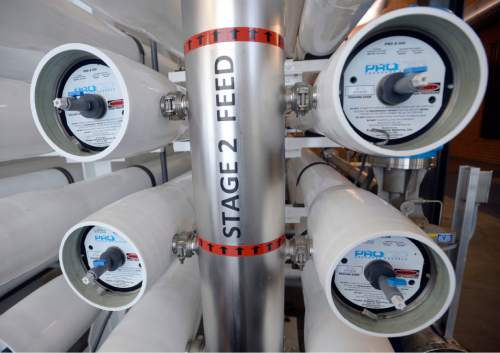This is an archived article that was published on sltrib.com in 2015, and information in the article may be outdated. It is provided only for personal research purposes and may not be reprinted.
For decades, Great Salt Lake shorebirds have been harbingers of the chemicals contaminating Utah's inland sea.
And soon, mallards — and more specifically their eggs — may be the gatekeepers of a $74 million water-reclamation project.
Private scientists will monitor the ducks' nests every year to determine the impact of a pipeline dumping 1.5 million gallons a day of wastewater — the byproduct of a public-private partnership between Kennecott Utah Copper and the Jordan Valley Water Conservancy District — on the lakebed.
Now, after more than a decade, the 21-mile pipeline's final stage is in sight: building a 1,000-foot extension that will spew water from two new reverse-osmosis plants straight into the lake.
The concentrations of trace minerals in the wastewater worry environmentalists and lake lovers alike.
The water agency and mining company's plan to clean up two contaminated groundwater plumes at the south end of the Salt Lake Valley essentially removes chemicals from underground aquifers fouled over decades of mining and dumps them in the briny lake at a time when chronic low water levels undermine its capacity to absorb pollution. At risk are the lake's flocks of migratory aquatic birds, which absorb selenium from the brine shrimp, brine flies and other tiny organisms that inhabit the lake and surrounding wetlands.
"If you don't have a place to dump the concentrate, then you haven't accomplished a single thing on behalf of the environment. It is possibly worse to dispose of concentrated toxins ... into a precarious ecosystem — which is precisely what you are doing here," Ivan Weber, a Salt Lake City environmental consultant, wrote to the U.S. Environmental Protection Agency.
But the cleanup has to happen. The plumes are slowly making their way to the Jordan River and, eventually, the lake. And EPA scientists concluded in March that the project would not result in "significant impacts."
That finding freed up $1 million in federal grants to pay for the final piece of pipeline, according to Shazelle Terry, water-quality manager for the Jordan Valley district. "We want to make sure we aren't causing unintended consequences," Terry said. But "that plume was making its way to the Jordan River anyway. All we are doing is speeding up a natural process."
—
Tailings to treatment • In 1988, Kennecott and state air-quality watchdogs reached a settlement that established a remediation fund to manage groundwater contamination.
For about 100 years, company miners dumped tailings directly onto the ground or into evaporation ponds at the western edge of Salt Lake County. Through the years, the minerals and heavy metals in that waste leached into groundwater, leaving two 50-square-mile plumes with thousands of acre-feet of tainted water.
A decade ago, the company and the water district tapped the cleanup fund to build two nondescript water-treatment plants — one in South Jordan, the other in West Jordan.
Jordan Valley district has sunk eight wells 800 feet down into "Plume B" and pipes the contaminated water a few miles downhill to the new plant at its West Jordan headquarters on the Jordan River around 8200 South.
Kennecott has been cleaning Plume A with a similar plant since 2006. Jordan Valley's plant went on line in 2013.
In reverse osmosis, which is commonly used in desalinization, water is squeezed under intense pressure through membranes that block all dissolved solids.
The West Jordan plant pumps the groundwater into the plant in silver pipes. After two stages of filtering, it concentrates the contamination by a factor of five into a waste stream that exits the plant in brown color-coded pipes and is pumped to Kennecott's Magna tailings pond.
For every four gallons of pure water, or "permeate," the process produces one gallon of "concentrate."
Clean water exits the plants in blue pipes and is delivered into Jordan Valley's network as culinary water.
Kennecott's remediation fund covered 80 percent of the project's cost, but Jordan Valley gets all the water.
Still, it's probably Utah's most expensive water because of the power needed to pump the water out of the ground, push it through the filters and get rid of the waste. Jordan Valley usually spends $4 to $7 on electricity to treat an acre-foot, a volume of water used by two to four Utah households in a year.
By contrast, the power bill for an acre-foot coming out of the reverse osmosis plant exceeds $100. "It never was just a water-development project, but a remediation project," said Terry. "It cleans up the water and puts it to beneficial use."
The 5,500 acre-feet the Jordan Valley plant will process each year won't exceed the rate at which the aquifer is being recharged with fresh water.
Water emerging from the filters is so pure that it needs further treatment.
"There is nothing in it. It would taste bad. It would be corrosive," Terry said. "We add calcium and other minerals to match the rest of our water."
The two plants combined yield 9,000 acre-feet a year, accounting for about 10 percent of Jordan Valley's total supply.
It will take 40 years to clean both plumes.
—
Little birds tell us • At its 2013 ribbon-cutting, state officials lauded the project for turning a liability into an asset.
But the plan has sparked concerns about ecological impacts since its inception in 2004. It initially projected discharging the concentrate into the nearby river, but that idea was quickly nixed.
Mercury and sulfates are in the plant's waste stream, but it is selenium, a metal that is naturally present in trace amounts, that most worries regulators and environmentalists.
Reverse-osmosis wastewater will spew from a 24-inch-diameter pipe into Gilbert Bay just as the Great Salt Lake reaches its lowest level in history. After a prolonged drought and repeated upstream diversions, a 50-year-old record low is expected to be broken this fall.
While crafting a permit for the pipeline, the Utah Division of Water Quality spent $2.5 million on several research projects over four years to tailor a selenium standard for the lake. It's based not on selenium suspended in the water, but on concentrations in bird eggs.
Regulators wanted first to answer a basic question: How would selenium in the wastewater affect migratory birds that depend on the great terminal lake 20 miles downstream?
"The thing with birds is they are exquisitely sensitive to it. The dose makes the poison," said Chris Cline, a biologist with the U.S. Fish and Wildlife Service. "It doesn't take a lot [of selenium] to lead to problems. It causes deformities in embryos."
Selenium is necessary for living organisms, but it can accumulate in tissue to unhealthy levels. "The difference between the amount they need and the amount that becomes toxic is really tight. It makes it hard to target things," said Wayne Wurtsbaugh, a limnologist with Utah State University who has studied the lake's ecology for years.
Researchers collected eggs from birds that "over-winter" at the lake (California gulls, stilts and avocets) and nesting birds (the common goldeneye, eared grebes and mallards) to determine the impact of the mineral waste on eggshell strength. Tissue samples also were taken from the birds and the bugs they eat.
After four years, scientists set a limit of 12.5 parts per million (ppm) allowed in the eggs. They concluded that at 12.5 ppm, egg viability would be cut by 10 percent. At that point, the birds' reproductive prospects would be threatened.
The standard is meant to mandate closer monitoring once lower selenium thresholds are reached. That way, the state can make adjustments before increasing selenium levels take a toll on the lake's ecology.
Before that point is reached, the state would adjust permits for any company or agency dumping water into Gilbert Bay. If the standard is violated, the state could declare the waters "impaired."
"We involved many stakeholders, and they did a good job getting the right number," said DWQ Director Walt Baker. "Hopefully we don't have to do that with other contaminants."
Monitoring will continue indefinitely. Eight mallard eggs are gathered each spring from five south-shore nesting sites and analyzed for their selenium levels.
Jordan Valley is piping its reverse-osmosis "concentrate" to Kennecott's massive tailings pond just south of the terminal lake. The Utah Division of Forestry, Fire and State Lands has issued an easement to construct the last stretch of pipeline across the lakebed to a final discharge point into an existing channel about a mile short of the current lake line. The district board is expected to review the easement at its June 3 meeting.
—
"Death by a thousand cuts" • Jordan Valley's 1.5 million gallons a day is dwarfed by discharges from Kennecott's Magna pond, which averages 35 million gallons a day.
But Kennecott's selenium concentrations are around half the 50 micrograms-per-liter in the district's concentrated wastewater.
All told, 1,500 kilograms of selenium reaches the lake each year from identifiable sources — about half from Kennecott and another 1,500 kilograms from sources that can't be accounted for, according to DWQ.
The water district's discharge will add a maximum of 224 kilograms to that load — an amount that wouldn't fill the bed of a pickup.
"Yes, it's a small amount, but it's added to a larger amount," Kim Shelley, DWQ environmental engineer overseeing surface water-discharge permits. "It accumulates and it becomes a problem. It's death by a thousand cuts."
Regulators say the selenium standard will protect the millions of birds that rely on the lake for nesting and as a stopover on their long migrations. But environmentalists wonder if it allows too much wiggle room for polluting industries.
Meanwhile, some critics say the state accepted an energy-intensive "dumb" choice for reclaiming Kennecott's old plumes, rather than requiring a cleaner alternative, such as using slower-working "digestives" to purify the water.
"Yes, [reverse osmosis] 'works,' but does it do what you intend?" Weber asked the EPA. "We suggest that it does not. Instead, it focuses danger and accelerates natural timetables."
It's a moot point, with millions of dollars invested in the two high-tech plants.



